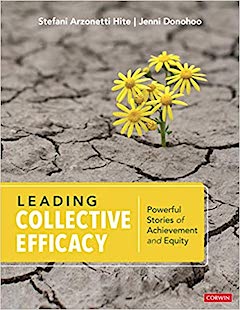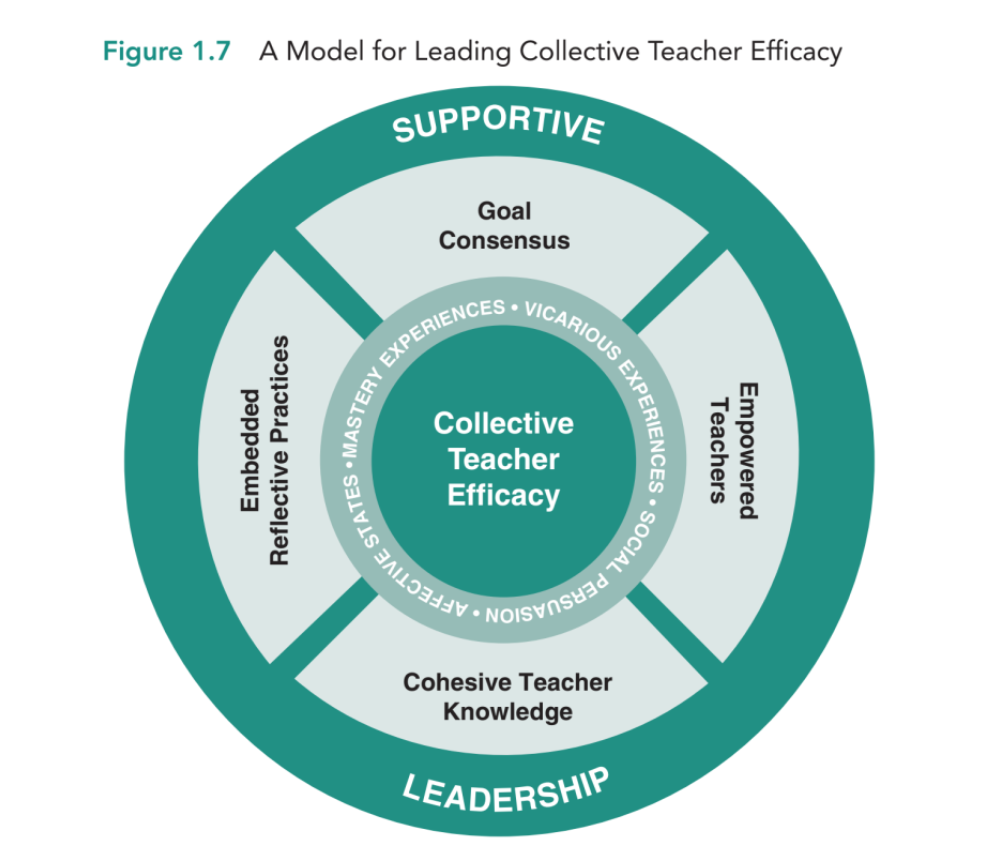“We noticed that schools and districts that had been highly intentional in building collective efficacy were far more resilient in the face of the extreme challenges that the COVID-19 crisis posed.” (Hite and Donohoo, 2020)
My mother has this very annoying – to me – habit of reading the end of a book first. I’ve never understood why she does that; it would spoil the story for me. And while I’ve never taken up my mother’s habit, I have to admit there have been a few fiction books where – midway through – I jumped to the end of the book to see if I really wanted to invest the time in finishing it!
 In the case of the recent Corwin bestseller, Leading Collective Efficacy: Powerful Stories of Achievement and Equity, I’m going to suggest that you begin by reading the last chapter – and perhaps highlighting the quote from that chapter which I’ve featured above.
In the case of the recent Corwin bestseller, Leading Collective Efficacy: Powerful Stories of Achievement and Equity, I’m going to suggest that you begin by reading the last chapter – and perhaps highlighting the quote from that chapter which I’ve featured above.
Collective teacher focus is needed now more than ever to address the unfinished learning disrupted by COVID-19. Quite simply, to ensure that teachers and students are supported and prepared, leaders must establish the structures and expectations that enable teachers to work together to identify the key learning standards so they can identify and address gaps.
This must be a team effort. If individual teachers are expected to do this on their own, they might burn out or find their students falling even farther behind.
What is Collective Teacher Efficacy?
It’s a different story when teachers work together, connected by the belief in their collective ability to succeed. This concept is called collective teacher efficacy and the authors define it as a “staff’s beliefs that through their collective action they can positively influence student outcomes, including those who are disengaged and/or disadvantaged” (p. xv).
Many of you are familiar with Jenni Donohoo, one of the two authors of this book. We’ve referred to Jenni’s previous books on collective efficacy in our work, and last summer she joined Jackie and me on a podcast to discuss her efficacy research.
Through storytelling, research and reflection, Donohoo and her co-author Stefani Arzonette Hite detail the important role leaders play in developing and strengthening collective efficacy in their school. They’ve organized their text around the model featured below, with a chapter devoted to each of the five components: Goal Consensus, Empowered Teachers, Cohesive Teacher Knowledge, Embedded Reflective Practice, and Supportive Leadership.
 So, in the spirit of the quote that opened this blog post, let’s look at how the model can help both teachers and leaders address students’ academic and social-and-emotional needs caused or intensified by COVID-19.
So, in the spirit of the quote that opened this blog post, let’s look at how the model can help both teachers and leaders address students’ academic and social-and-emotional needs caused or intensified by COVID-19.
Component One: Goal Consensus
The authors define goal consensus being reached “when faculty that has engaged in a process for identifying goals comes to an agreement about the school’s goals” (p. 17). Imagine what this might look like if a school committed to focusing on the identified essential standards for each grade and content area. (You can download the critical standards table for grades K-12 here.)
If teachers agree to that goal and focus, then structures and processes are co-developed with leadership support. This support includes providing the critical time and resources for teachers to work together and plan lessons and units focusing on those standards.
Component Two: Empowered Teachers
Once the goal is established and agreed to, then teachers are empowered to collaborate to develop high quality lessons around the critical standards. The authors underscore the importance of teacher empowerment, pointing to research showing its positive influence on teachers’ expectations and on student learning (p. 39).
After developing the lessons, teachers might create common formative assessments to gauge progress and meet to examine the results and make adjustments, if needed. Tracking progress can also reinforce teachers’ individual and collective beliefs in their ability to reach all students.
Component Three: Cohesive Teacher Knowledge
Years ago, I remember the late Rick DuFour describing a dysfunctional school where teachers were “independent contractors connected by a common parking lot.” The antidote to a situation like DuFour described is cohesive teacher knowledge, which the authors define as “the degree to which teachers are aware of the teaching practices of others and their agreement in regard to what constitutes effective assessment and instructional practices” (p. 55).
Let’s imagine. Imagine the team of teachers examining the results of a common formative assessment and deciding to observe the teaching strategies of a colleague whose students mastered the content. Imagine having the opportunity to regularly visit each other’s classrooms to learn from and encourage one another.
Knowing that you are not alone, that you have a team working with you to ensure the success of your students and all students in the school can be so empowering!
Component Four: Embedded Reflective Practices
The way to accomplish some of the ideas listed above is through embedded reflective practice. Important aspects of reflective practice include (p. 79):
✻ Collaborative examination of student learning data. (What is our greatest need?)
✻ Identification of evidence-based approaches. (What should work in theory?)
✻ Repeated trial of evidence-based strategies in classrooms. (How can we best leverage evidence-based approaches given our unique context and our unique students?)
✻ Re-examination of evidence. (What is our collective impact? Are we making progress toward our goals?)
Component Five: Supportive Leadership
 None of this can happen without the consistent support of leadership. The authors suggest a powerful metaphor to illustrate this need: “Supportive leadership represents the container—the space—for the other elements to flourish” (p. 99). Leaders empower teachers to take risks by embracing mistakes as an opportunity to learn. They provide structures and processes to enable teachers to learn and plan together. And, as they monitor progress, they celebrate success with an eye on continuous improvement.
None of this can happen without the consistent support of leadership. The authors suggest a powerful metaphor to illustrate this need: “Supportive leadership represents the container—the space—for the other elements to flourish” (p. 99). Leaders empower teachers to take risks by embracing mistakes as an opportunity to learn. They provide structures and processes to enable teachers to learn and plan together. And, as they monitor progress, they celebrate success with an eye on continuous improvement.
We’re All in This Together
As schools and districts move forward and increasingly focus on developing strategies for addressing the lingering effects and long-term challenges caused by COVID-19, we should all remember the mantra: “All of us are better than any one of us.” Building and strengthening collective teacher efficacy help ensure that both teachers and students succeed and thrive.
Cathy Gassenheimer is Executive Vice President of the Alabama Best Practices Center


0 Comments on "Leading Our Schools into the Future with Collective Efficacy"